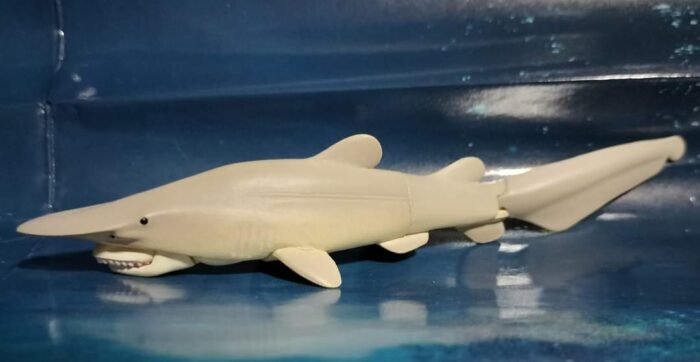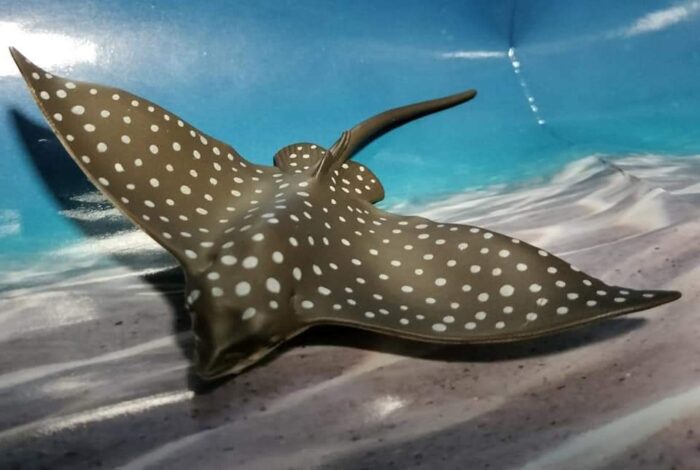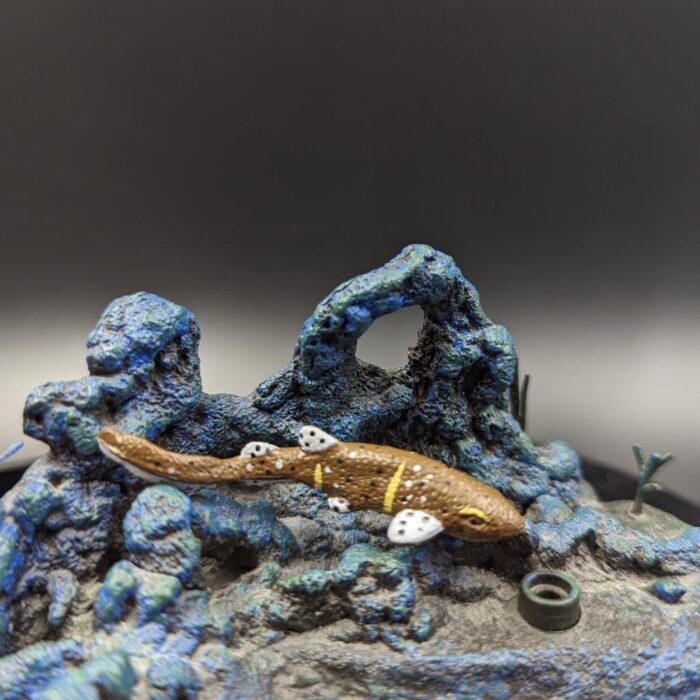Quite a few shark species go by the name “reef shark”. Blacktip, Caribbean, grey, and the subject of today’s review, the whitetip. But while all those sharks belong to the Carcharhinus genus, the whitetip reef shark (Triaenodon obesus) does not. But these sharks are not called reef sharks because they’re related.
Mini Sharks (Diversity of Life on Earth by Bandai)

Review and images by JimoAi; edited by bmathison1972
As previously mentioned, 2023 has been a great year for cartilaginous fish fans with, many figures from big and small companies alike. Today, we will be taking a look at the Bandai’s Mini Sharks collection which is part of their Diversity of Life on Earth series.
Saltwater Fish in Colour Part 1, Part 3: The Secrets (Yujin)

Review and images by JimoAi; edited by bmathison1972
To close off my Yujin Saltwater Fish in Colour Part 1 reviews (see the first parts here and here), I am hereby reviewing the last 3 of the fish; they’re all the secret and chase pieces. Instead of going by numerical numbers, I’ll start from the weakest to the best (in my opinion).
Great White Shark (Folkmanis)

Review and images by Suspsy; edited by bmathison1972
Behold, I give you the biggest shark toy in my possession, the great white (Carcharodon carcharias) from Folkmanis! I came across this magnificent puppet in a local toy store more than fifteen years ago. I was in my mid-twenties at the time, single without any children, and the price tag was a hefty $89.99 Canadian.
Goblin Skark (The Sharks Vol. 2 by Takara Tomy A.R.T.S.)

Review and images by JimoAi; edited by bmathison1972
The goblin shark (Mitsukurina owstoni) is the only living member of the family Mitsukurinidae, with other members dating back to the early Cretaceous, which is in the order Lamniformes which includes such All Stars such as the great white, mako, basking, megamouth, and others.
Frilled Shark (Diversity of Life on Earth: Mini Ancient Fish by Bandai)

The frilled shark (Chlamydoselachus anguineus) is an enigmatic anguilliform shark in the family Chlamydoselachidae. There is one other extant member of this family, the South African frilled shark (C. africana). They are considered among the most primitive extant sharks. Frilled sharks occur nearly worldwide, usually in the waters of the outer continental shelf and upper continental slope.
Swellshark (Shark Bulk set by K&M International)
Blue Whale, 2018 (Sealife by CollectA)

Review and images by Suspsy; edited by bmathison1972
Well, here it is, my review of the final sample animal toy from Happy Hen Toys—for now. Once again I must express my deepest thanks to them for such wonderful generosity. And I’ve saved the very biggest for last: CollectA’s second version of the massive and marvelous blue whale (Balaenoptera musculus).
Penguins of the World (Colorata)

Recently, when forum member Suspsy reviewed the Papo emperor penguin, I made a comment that I also had this figure, and it was one of only a couple figures I didn’t initially retain from Colorata’s Penguins of the World box set. After I published that comment it got me thinking, and I revisited the three figures from that set I didn’t retain (the other two were the chinstrap penguin and rockhopper penguin, both of which I went with Safari Ltd.’s versions).
Japan Deep Sea Life Bath Bomb Collection (Moritoku)

Review and images by JimoAi; edited by bmathison1972
While deep sea life figures are seen as a rare treat amongst the western market, Japan has been mass-producing them for many years since the early 2000s, where they have been made into both high quality figures for collectors and sometimes also cheap novelty toys.
Spotted Eagle Ray (Marine Life by Papo)

Review and images by JimoAi; edited by bmathison1972
In the past reviews, I’ve lamented on how there isn’t enough rays represented in plastic. So far, in the last 3 years there have been quite a few cartilaginous fish figures made, some that are underrepresented: 2021 gives us a Helicoprion and Cretoxyrhina from PNSO, a really stylised great white shark branded as a megalodon from Papo, an awesome basking shark from CollectA, a set of stylized ray figures from Kitan Club, and a Xingu river ray by Kaiyodo.
Ocellaris Clownfish (Nature Techni Colour: Toba Aquarium by Kitan Club

Review and images by JimoAi; edited by bmathison1972
In a lagoon within the Great Barrier Reef, the little residents are out and about their colorful home doing what animals do to survive: eat, socialize, adjust to changes, reproduce, and not get themselves eaten. What appears to be a ball of hair is one of the more predatory residents: the sea anemone.





